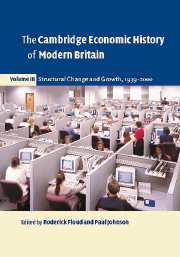Book contents
- Frontmatter
- Chapter 1 The war-time economy, 1939–1945
- Chapter 2 Failure followed by success or success followed by failure? A re-examination of British economic growth since 1949
- Chapter 3 The performance of manufacturing
- Chapter 4 A failed experiment: the state ownership of industry
- Chapter 5 Employment, education and human capital
- Chapter 6 Money and monetary policy since 1945
- Chapter 7 The financial services sector since 1945
- Chapter 8 Economic policy
- Chapter 9 The welfare state, income and living standards
- Chapter 10 The rise of the service economy
- Chapter 11 Impact of Europe
- Chapter 12 Technology in post-war Britain
- Chapter 13 Regional development and policy
- Chapter 14 British fiscal policy since 1939
- Chapter 15 Industrial relations and the economy
- References
- Index
Chapter 11 - Impact of Europe
Published online by Cambridge University Press: 28 March 2008
- Frontmatter
- Chapter 1 The war-time economy, 1939–1945
- Chapter 2 Failure followed by success or success followed by failure? A re-examination of British economic growth since 1949
- Chapter 3 The performance of manufacturing
- Chapter 4 A failed experiment: the state ownership of industry
- Chapter 5 Employment, education and human capital
- Chapter 6 Money and monetary policy since 1945
- Chapter 7 The financial services sector since 1945
- Chapter 8 Economic policy
- Chapter 9 The welfare state, income and living standards
- Chapter 10 The rise of the service economy
- Chapter 11 Impact of Europe
- Chapter 12 Technology in post-war Britain
- Chapter 13 Regional development and policy
- Chapter 14 British fiscal policy since 1939
- Chapter 15 Industrial relations and the economy
- References
- Index
Summary
INTRODUCTION
The outbreak of the Second World War drew Britain into a new phase of its historic, geopolitical and economic relationships with the European continent. Nazi domination of the continent completed the economic cut-off that began with the proliferation of exchange controls in the 1930s. Reliance on the United States as the ‘arsenal of democracy’ inserted US economic policy into the framework of imperial preference that had worked well for Britain’s economic recovery in the 1930s. Mobilising the Empire’s world-wide resources while co-ordinating America’s military contributions throughout the Second World War, Britain’s policy makers laid the foundation for the country’s post-war relationships with its overseas Empire, the USA and Europe. Britain’s relationships in these three world regions varied over the period 1939–99 in response to a succession of external shocks: first and foremost came the shock of the Second World War, but that was followed in rapid sequence by shocks from the disastrous effects of the temporary resumption of convertibility of the pound sterling into gold or dollars in 1947, then the outbreak of the Korean War in 1950, the Suez Crisis of 1956, the successive oil shocks of 1973, 1979 and 1986, and the German reunification shock of 1990. Europe experienced the same shocks, to be sure, but in different ways, so the continental nations often responded with different strategies from those adopted by Britain.
- Type
- Chapter
- Information
- The Cambridge Economic History of Modern Britain , pp. 267 - 298Publisher: Cambridge University PressPrint publication year: 2004
- 2
- Cited by

